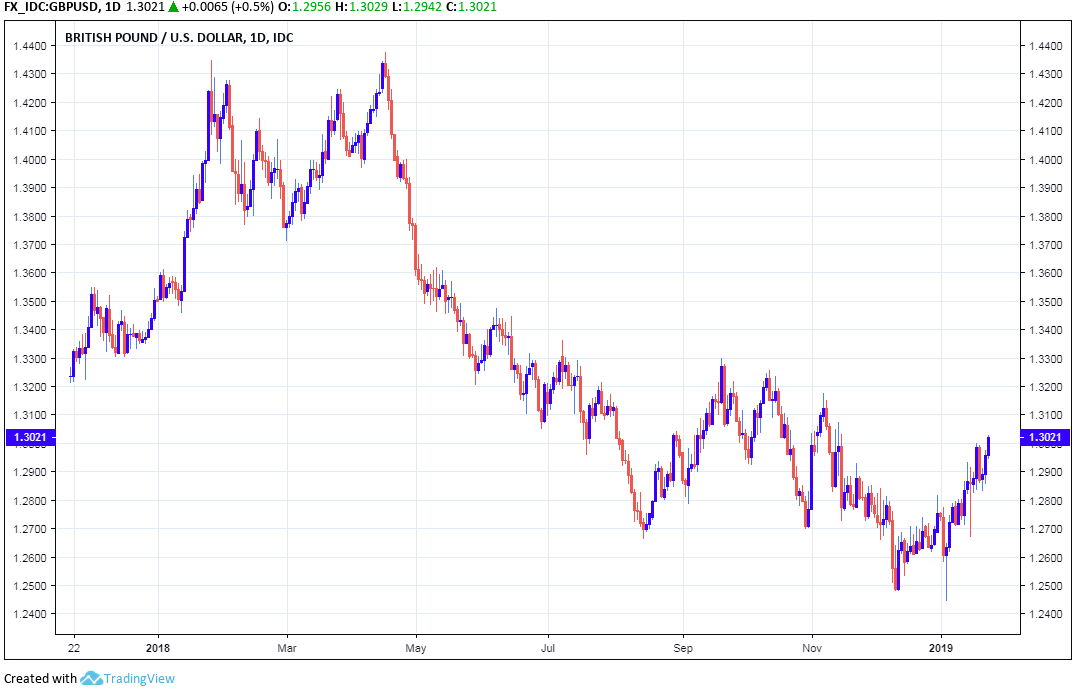Pound-to-Dollar Rate Can Rise Further say Analysts, but Beware of Misplaced Hope!
- Written by: James Skinner
-

© IRStone, Adobe Stock
- GBP outperforms G10 rivals as market bets on Brexit retreat.
- Market eyes Art 50 extension, exit-nullifying referendum or election.
- But BMO sees optimism misplaced, forecasts GBPUSD losses.
The Pound is one of the best performing currencies this January and can still rise further against the Dollar over the coming days and weeks, according to some analysts, but others say the market is in danger of getting ahead of itself.
Hopes of an extension to the Article 50 EU withdrawal period that ultimately leads to a second referendum, a Brexit-cancelling election or some other kind of exit-nullifying agreement between the political parties in Westminster have been behind Sterling's January rise.
This is because with no majority in parliament for government's Brexit proposals, Prime Minister Theresa May has been left with little choice but to consult the opposition in the hope of reaching a consensus about what to do next.
Increasing numbers of analysts are of the view that Brexit-supporting opponents of PM May's deal are on the verge of backing it in order to see off the threat of the departure being cancelled altogether.
"There is good news for us to hope that a reformation of this deal could make it acceptable but it is not there yet and until then we will vote against the deal,” says Jacob Rees-Mogg, leader of the Brexit-supporting voices in the Conservative Party, in an address to The Bruges Group Wednesday.
The Pound has has now risen by 2.2% against the Dollar in 2019 as a result of this optimism, making it the second best performing G10 currency after the Canadian Dollar, and technical analysts are saying it can go even further still over the coming days and weeks.
"GBP/USD remains bid near term and is once again approaching the 1.3000 level. Initial support is the near term up trend at 1.2838. We regard the recent move to 1.2444, charted in January, as the end of the down move and we look for gains to the 200 day moving average at 1.3075," says Karen Jones at Commerzbank.
Jones says the Pound-to-Dollar rate could rise all the way to 1.3258, and then .3363, if it overcomes the 200-day moving average that sits around the 1.3075 level. Momentum studies like the relative-strength index suggest this is likely, while other indicators point to dips lower being arrested around the 1.2773 area.

Above: Pound-to-Dollar rate shown at daily intervals.
The Pound-to-Dollar rate was quoted 0.54% higher at 1.3026 Wednesday, making it the best performing G10 currency for the session and putting it on a 2.24% return for 2019.
The Commerzbank team are holding a small "long" position in their portfolio, meaning they are betting the rate will rise, but they say they'll look to close the trade at 1.3065, ahead of the big moving average up at 1.3075.
Commerzbank's intention to exit its trade ahead of the 1.3075 level suggests the analyst team has doubts about whether the rate really will overcome that threshold represented by the 200-day moving average.
Those apparent doubts are in keeping with the view and forecasts put out by BMO Capital Markets on Tuesday, which suggest the Pound-to-Dollar rate will soon succumb to fresh losses as the market is forced to acknowledge the true extent of the parliamentary impasse over Brexit.

Above: Pound-to-Dollar rate shown at hourly intervals, capturing the 2019 trend.
Prime Minister Theresa May needs consensus and a parliamentary majority, but the opposition and some members of the May's own Conservative Party say her plan will put too much distance between the UK and EU.
Meanwhile, supporters of Brexit in both the Conservative Party and wider country say it will deliver nothing more than an exit in name only. But some also say it would lead to a situation that is even worse than that.
This underlines perfectly the extent of division in the British political establishment over Brexit, while highlighting the threat posed to the Pound by potentially misplaced optimism among traders that the exit process can be either slowed or stopped altogether.
"We think Brexit will result in either a “no deal” scenario on March 29th or an extension of Article-50," says Stephen Gallo, European head of FX strategy at BMO Capital Markets, in a note to clients Tuesday.
Article 50 of the Lisbon Treaty gives the UK until March 29 before it leaves the EU, with or without a deal governing terms of the departure and future relationship. PM May's exit plan was rejected by parliament in a landslide vote earlier this January so the current legal position is the UK will leave in March and default to trading with the EU on World Trade Organization terms.
However, MPs are tabling their own amendments to PM May's deal ahead of parliamentary debate and vote scheduled for January 29. The market sees two of those amendments as potentially being a game-changer, given they could require the government to either request an extension of the Article 50 period, or offer parliament a vote on whether to hold a referendum that would enable Brexit to be cancelled.
"We assign the “no deal” scenario a 40% probability and an Article-50 extension leading to one of three additional permutations a 50% probability. No deal by March 29th would see GBPUSD fall to 1.20," Gallo warns.
The biggest problem for the Pound is that the EU has to agree to an extension of Article 50 and, from it's perspective, the idea would be pointless unless there's a credible prospect that such a thing would eventually see the Withdrawal Agreement ratified, or lead to a potentially Brexit-cancelling second referendum or general election.
The second big problem for Sterling is there's no majority in parliament or among the electorate for a second referendum, while the governing Conservative Party could easily be booted from office if Prime Minister Theresa May was to hold another election.
BMO's Gallo says there is a chance that any extension of Article 50 simply leads to another extension further down the line, as it wouldn't necessarily resolve the parliamentary gridlock.
The BMO team's forecast is that because of this situation and the uncertainty that results from it, the Pound-to-Dollar rate will fall from 1.30 Wednesday, to 1.25 before the end of March.
Time to move your money? Get 3-5% more currency than your bank would offer by using the services of foreign exchange specialists at RationalFX. A specialist broker can deliver you an exchange rate closer to the real market rate, thereby saving you substantial quantities of currency. Find out more here.










